

Originally, this card was not associated with the image of the solitary sage we know today. In Italy, it was referred to as "il gobo" (the hunchback) and "il vecchio" (the old man), terms that alluded to the effects of time on the human body, especially old age and the physical trials that accompany it. Sometimes, this character was associated with Saturn, the god of time. The poet Petrarch, in his works, evokes the triumphs of human life, including the triumph of time, a meditation on the ephemeral nature of life.
However, over time and adaptations in different countries, this representation evolved. The old man became the hermit, a figure of wisdom and reflection, carrying a walking stick and a lantern.
The Hermit's lantern is a powerful symbol. It can evoke the story of Diogenes of Sinope, a Greek philosopher of the 4th century BC, known for his austere lifestyle. Diogenes walked through cities with a lantern in broad daylight, proclaiming that he was looking for a true man. This image of Diogenes, often depicted with a lantern, a stick, and a dog, emphasizes the idea of a quest for truth and wisdom.
In a Renaissance Italian tarot, Diogenes is depicted in his barrel, illustrating his disdain for material possessions and his commitment to simplicity. This reference to Diogenes in the Hermit card reinforces the idea of spiritual quest and detachment from earthly concerns.
In old French tarots, the Hermit was sometimes depicted as a religious pilgrim, carrying a rosary or a rope belt. This image highlights the spiritual and contemplative aspect of the card. The Hermit's beard is also an important symbol. In monastic traditions, such as that of Mount Athos, the beard was a sign of devotion and separation from the secular world.
Initially, the Hermit card symbolized the ravages of time and old age. However, over time, this interpretation evolved into a more spiritual meaning. Today, the Hermit is seen as a figure of wisdom and contemplation, representing a voluntary retreat from the world to achieve a deeper understanding of life.
This transformation shows how symbols and interpretations can evolve, reflecting changes in culture and human values. The Hermit of the Tarot of Marseille has thus become a spiritual guide, illuminating the path with his lantern, a symbol of inner quest and wisdom gained through experience and reflection.
The Hermit card is a striking example of the evolution of symbols in tarot. From the image of an old man affected by time, it has transformed into that of a solitary sage in search of truth. This card reminds readers of the importance of inner reflection, the quest for wisdom, and the understanding of life's mysteries.
Christian tradition speaks of four cardinal virtues: strength, justice, temperance, and prudence. In the 22 major arcana of the Tarot de Marseille, we find Strength (arcana 11), Justice (arcana 8), and Temperance (arcana 14). However, prudence seems absent. This absence has prompted much reflection among tarot students.
French occultists have identified the Hermit as a possible embodiment of prudence. Oswald Wirth, a prominent occultist, considers the Hermit a figure capable of distinguishing good from evil, learning from the past, making wise choices in the present, and planning for the future. His lantern, a symbol of the light of the mind, illuminates the past, present, and future, thus encompassing the three dimensions of time, reminiscent of Petrarch's allegory of time.
In his version of the tarot, Oswald Wirth added elements to reinforce this association with prudence. He integrated a serpent, a traditional symbol of prudence, referencing a quote from the Gospel of Matthew (10:16): "Be wise as serpents." The serpent is also a symbol of wisdom and renewal. Wirth also replaced the Hermit's traditional walking stick with a bamboo cane with seven knots, symbolizing the seven levels of consciousness or the seven chakras, adding a spiritual and esoteric dimension to the card.
Arthur Edward Waite, creator of the Rider-Waite-Smith Tarot, departs from Wirth's occult interpretation. For Waite, the Hermit is not a figure of isolation or a quest for wisdom. He sees him more as a spiritual guide who, having already achieved a form of wisdom, uses his lantern as a beacon to light the way for others. In his tarot, the Hermit is depicted at the top of a hill, symbolizing achievement and the ability to guide others to the same spiritual heights.
In the Wildwood Tarot, the card is not called the Hermit, but "The Hooded Man." This designation gives the figure a more mysterious and less explicitly wise aspect. The card does not specify the subject of the image: the man himself, the bird perched on a rock, or the huge tree in the background, guardian of the forest.
The symbols present on this card enrich its meaning. For example, the holly visible on the man's tunic symbolizes resilience and protection. Its thorns evoke fierceness, while the longevity of its leaves represents courage. Holly is also a symbol of persistence during winter, offering refuge for good spirits and lost travelers.
In the background, we see a holly wreath, inherited from Roman and Germanic traditions celebrating the winter solstice. This wreath symbolizes the rebirth of the sun and the triumph of light over darkness. Thus, the Hooded Man might be searching for something in the winter cold, perhaps looking for himself, represented by a closed door in the huge tree in the background, symbolizing wisdom and protection.
This version of the Hermit is not necessarily the classic sage. The tree behind him represents wisdom and experience. The card suggests a connection between the man and nature, a humble pilgrimage through the forest, seeking to draw on the wisdom and strength of nature.
The theme of resilience and perseverance is also central. Like nature, the man must show tenacity to find light in the midst of darkness. The man's face being hidden, he could symbolize a ghost or a man seeking himself, ready to pass through the door to a new understanding of himself. Thus, "The Hooded Man" of the Wildwood Tarot emphasizes mystery and spiritual quest in a natural context.
The bird perched on the rock at his feet evokes the idea of awakening and freedom. As the man and bird face each other, one might wonder if the man seeks to fly, to find his inner freedom.
The Hermit card of the Tarot of Villeneuve offers a less symbolically loaded perspective than that of the Wildwood Tarot. However, it remains rich in meaning and offers an interesting interpretation of the inner journey and quest for wisdom.
In this version, the Hermit is depicted as a small man lost in a mineral, underground environment. He has just entered this cave through an opening leading outside and crosses a bridge over a chasm that may plunge to the center of the earth. Equipped with his lantern, he ventures into the depths. The Hermit's underground journey is an allegory of working on the unconscious. By exploring these depths, the man symbolizes the introspective quest and the search for understanding the most hidden corners of his soul. The mineral environment and the crossing of the chasm perhaps highlight the difficulty and rigor necessary for the quest for inner truth.
A notable detail of this card is the presence of a stalactite descending from the ceiling and a stalagmite rising from the ground, placed exactly one above the other. This image can symbolize the potential union between earth and sky, or the connection between body and mind. The Hermit, crossing the bridge, might seek to achieve this union, to harmonize his consciousness and unconscious. This union could also be interpreted as an integration of opposites, an alchemical realization where the celestial meets the terrestrial, where spirituality meets materiality.
The Hermit of the Tarot of Villeneuve recalls several essential aspects of traditional symbolism while offering a new perspective on the quest for wisdom. Comparison with the Tarot of Marseille
In the Tarot of Marseille, the Hermit is often seen as a spiritual guide, lighting the path of inner knowledge with his lantern. The card symbolizes prudence, introspection, and wisdom acquired through experience. The Tarot of Villeneuve retains this aspect of inner quest but anchors it more in an exploration of the unconscious, symbolized by the underground journey.
In The Muse Tarot, the Hermit card is strongly associated with the idea of journeying and solitude. This version of the card places us in a desert, an environment that recalls the etymology of the term "hermit," which appeared in the 12th century. The word comes from the Christian Latin "eremita," itself from the Greek "eremites," meaning "of the desert" or "one who lives in solitude."
The card shows a female figure, a young woman kneeling before a shrub, which is a visually different but symbolically rich interpretation. The desert represents solitude and the path to self-knowledge, marked by the footprints in the sand leading to the shrub.
The theme of solitude in a desert highlights the idea that the path to self-knowledge can be arduous and demanding. The presence of the shrub emphasizes the importance of patience, humility, and perseverance, essential qualities for growth and evolution, even in the most difficult conditions. Unlike other versions where the Hermit seems more serene and detached, here, the focus is on the struggle and effort necessary to achieve inner light. The woman's kneeling posture can also be interpreted as submission or devotion, contrasting with the traditional image of the Hermit as an independent and enlightened guide.
The shrub, as in the Enchanted Forest card, symbolizes wisdom, perpetual evolution, and ascension to the sky. It evokes verticality and the cyclical nature of cosmic evolution, including life, death, and rebirth. The tree's leaves, which fall and are reborn each year, reinforce this idea of natural cycles.
The troubadours' texts, storytellers, and poets of all eras have often sung of the tree as the axis of the world, the flame of life, and the bridge between heaven and earth. Through its verticality, the tree is a sacred place where the roots plunge deep into the earth while its branches rise to the sky, connecting the three levels of the cosmos.
On this card, the young woman kneeling before the shrub seeks to connect with her own depth and spirituality. A star, shining like a sun, lies between her and the shrub, symbolizing her quest for light and knowledge through humility and reverence. The Hermit card in The Muse Tarot enriches our understanding of this emblematic figure through an interpretation focused on personal development and spirituality.
In the Wake Me Up Tarot, the Hermit card appears simple at first glance. It shows a man in a tailor's position, sitting on a cushion, deep in meditation. Next to him, a lit lantern and two candles illuminate the scene. Above his head, a poster shows the different phases of the moon.
Meditation is a key element of this card, suggesting that to find the light and move forward on one's path, it is necessary to turn inward. The phases of the moon on the poster symbolize evolution. The moon, a night star, with its phases, illustrates the journey of light through darkness and vice versa. This is particularly relevant for the Hermit card, which speaks of the quest for light amid darkness, representing spiritual growth and inner search.
Another important symbol is the key placed on a cage containing a laptop. This detail evokes the man's reflection on a form of addiction. Locking the laptop in a cage and placing the key on its top indicates an awareness of modern distractions, such as social networks and video games. The card suggests a need to detach from daily stimuli that consume our energy without truly enriching us.
Finally, a digital alarm clock showing 11:11 rests on the cage. The number 1 is symbolically powerful, representing beginnings, uniqueness, independence, and autonomy. Four number 1s, forming 11:11, reinforce this idea, suggesting the construction of solid foundations (symbolism of the number 4) and the unification of opposing forces within ourselves.
The Hermit card in the Wake Me Up Tarot offers a contemporary and introspective interpretation of this classic figure. This version of the Hermit highlights the importance of meditation and introspection to overcome the distractions of modern life. It emphasizes the need to temporarily withdraw from the world to recentre and find inner light. The key and the cage represent the power to break free from addictions and harmful habits.
On the other hand, this interpretation can be seen as less universal and more specific to current society, where technologies and social networks play a central role. Some may find that this limits the symbolic scope of the Hermit, making it too rooted in the present, to the detriment of its timeless meaning of spiritual quest and wisdom.
In the Housewives Tarot, the Hermit is represented by a woman taking a bath, surrounded by soaps. This image adopts a different perspective but remains symbolically coherent. The bath evokes the need for purification and cleansing, both physical and emotional. Washing can be interpreted as freeing oneself from past mistakes and sins, a form of symbolic rebirth.
This interpretation is out of step with the traditional representation of the Hermit, but it adds an interesting dimension. Water, in astrology, is linked to emotions, the unconscious, and introspection. Immersing oneself in a bath can therefore symbolize diving into one's own emotions and thoughts, similar to the traditional Hermit who explores the depths of his mind.
Psychologically, the Hermit invites introspection and reflection. It encourages taking time for oneself, away from distractions and external influences, to better understand one's thoughts and emotions. This inner retreat is essential to achieving mental clarity and increased wisdom.

Key words for the 78 cards for the Tarot of Marseille and the Rider-Waite-Smith, to slip into your favorite deck. Your leaflets always with you, at hand, to guide you in your readings. Thanks to them, your interpretations gain in richness and subtlety.
To understand the Hermit card, it is essential to place it in the context of the Fool's Journey. After the Lovers card (6), which speaks of a choice driven by interest rather than the heart, comes the Chariot card (7), symbolizing the relentless pursuit of our desires, often at the expense of a balanced relationship with others. Then, the Justice card (8) confronts us with the consequences of our unilateral actions and the reaping of what we have sown, often bringing disillusionment and natural arbitrary justice.
The Hermit card, which concludes this cycle, does not speak of finding light within oneself or in the darkness, but rather of illuminating the darkness. It is about shedding light on our failures and understanding the reasons for these failures. Justice shows us how much we have failed in our conquest (Chariot), and the Hermit guides us to illuminate what is most repressed, hidden, and secret within us—all that we do not wish to admit.
The Hermit invites us to explore our shadow areas, our mistakes, and our secrets. It is not about seeking what is precious and luminous within us, but about shedding light on our darkest aspects. This uncompromising introspection is crucial for our personal evolution. If Justice confronts us with others and the laws of nature, the Hermit confronts us with ourselves. It is an internal assessment, a judgment of our own actions, where we must understand the reasons for our failures.
This deep analysis of our mistakes is necessary because it precedes the Wheel of Fortune card (10), which symbolizes a new cycle, new opportunities, and new paths to take. To seize these opportunities and continue our life journey, it is imperative to learn from our past mistakes. This is the ultimate lesson of the Hermit: learning from mistakes to evolve.
The Hermit card in the Tarot de Marseille is a valuable guide for introspection and exploring our inner darkness. It invites us to illuminate our mistakes, understand the reasons for our failures, and learn from them to evolve. By finding a balance between reflection and action, between solitude and connection, we can truly move forward on our life path and seize the new opportunities offered by the Wheel of Fortune.
| Symbolic interpretation | Right direction (Positive) | Awareness, perspective, meditation, research, deepening, solitude, sobriety, simplicity | Reverse direction (Negative) | Isolation, withdrawal, slowness, hesitation, silence, procrastination, poverty, losses, nostalgia, penance |
| Psychological interpretation | Right direction (Positive) | Demanding, persistent, enduring, sharp, insightful, modest | Reverse direction (Negative) | Paralyzed, discouraged, pessimistic, cowardly, blind, misanthropic, self-effacing |
| Advice | |
| Stop to understand. Seek solitude. Illuminate the darkness within you. Confront your inner demons. Look at yourself in a mirror. Accept the situation. Change your priorities | |
| Thematic Interpretation | Love | Internalized or declining feelings. Solitude sought or suffered. Romantic disappointment. Bitterness after a breakup | Work | Professional or skills assessment. Career plan in decline. End of a difficult (or not) project. Retirement | Money | Term investment. Need to review investments. Abandonment, donation, or resale of assets | Family / Friendships | Family at a distance. Questioning blood ties. Searching for truth | Health | Acceptance of aging (or not). Need for inner fulfillment. Meditative or spiritual practice |
| Divination / Prediction | Who ? | An elderly or wise person. A loner. A monk. A hardened bachelor. A wanderer. A whistleblower | Where ? | An isolated place. A monastery. A place of reflection. A bench in a park. A boat. The sea and the horizon. His room. A window | When ? | An end of a contract. A romantic or friendly breakup. A spiritual retreat. A wellness course. A distant trip. Watching the years go by | How ? | By taking stock. By confiding. By writing in a journal. By meditating. By looking at a landscape. By talking to grandchildren. By passing on knowledge |
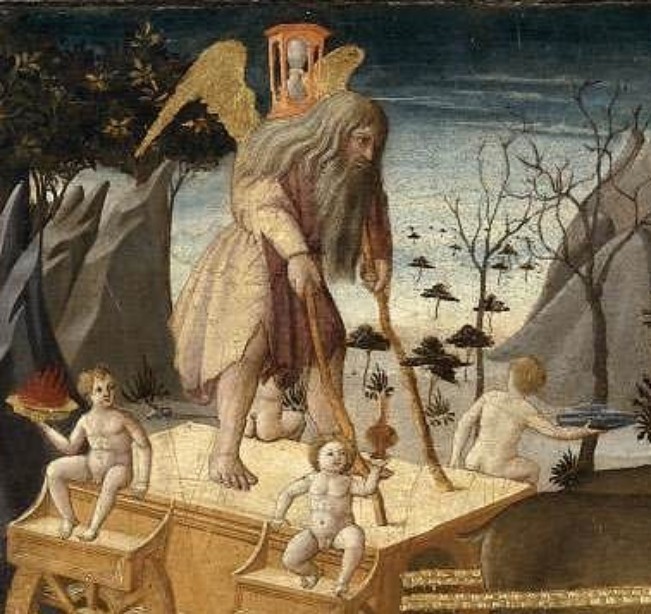
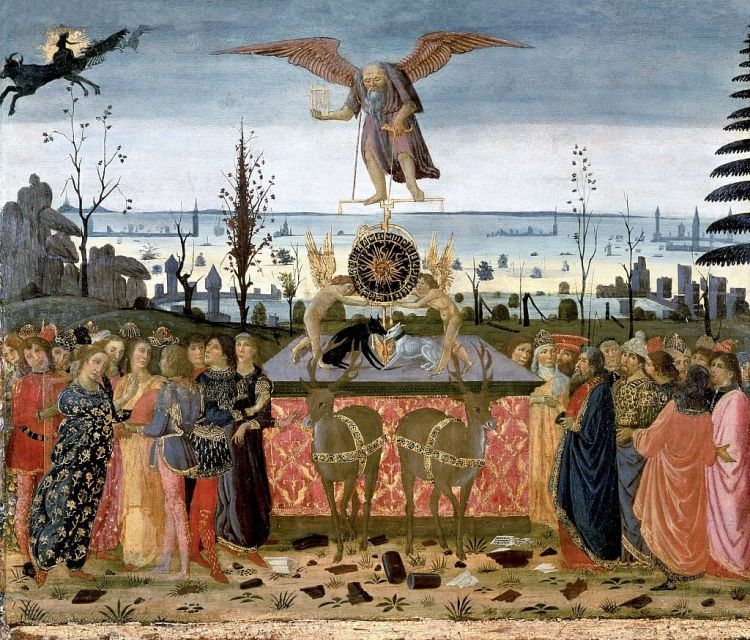
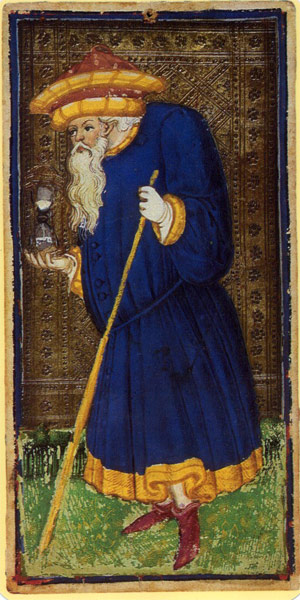


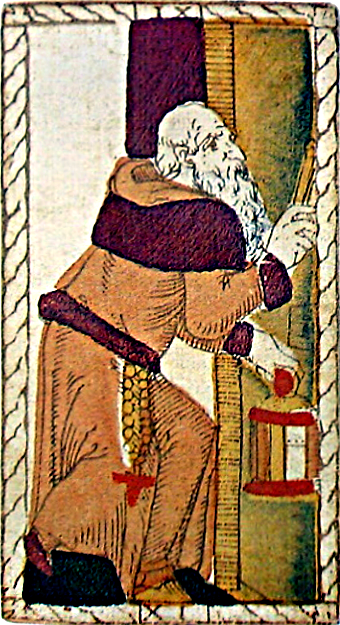

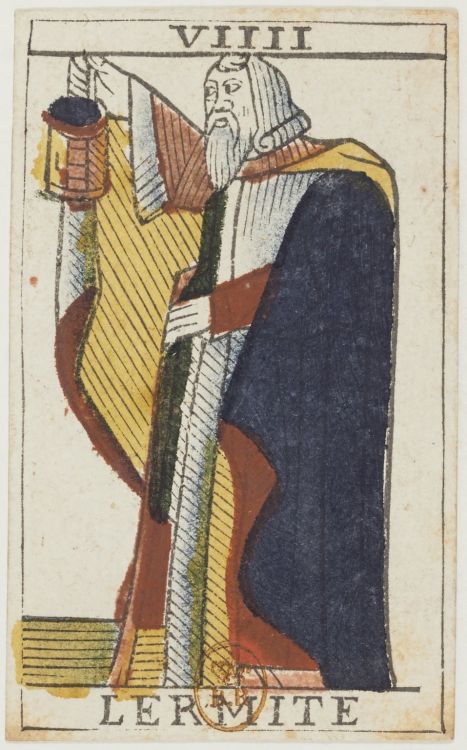
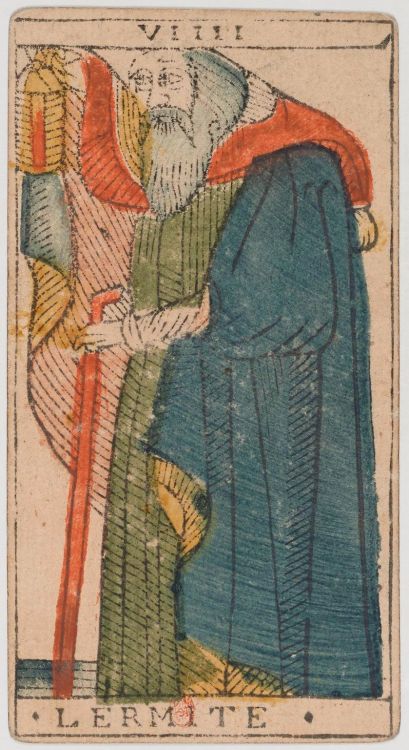
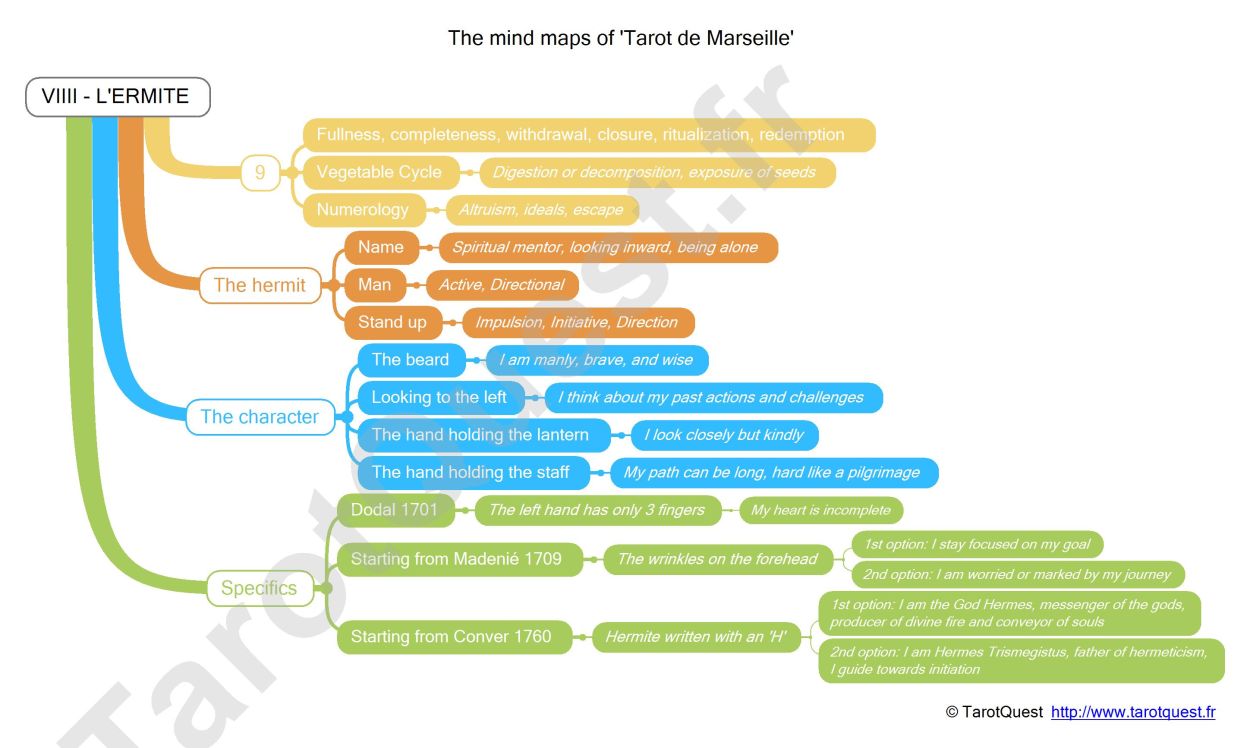

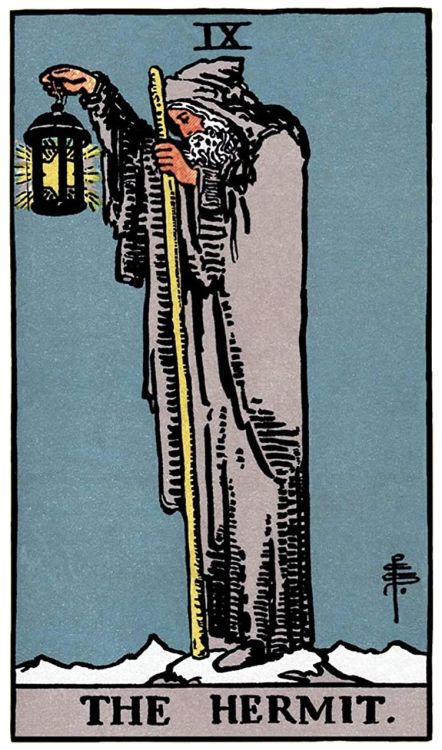
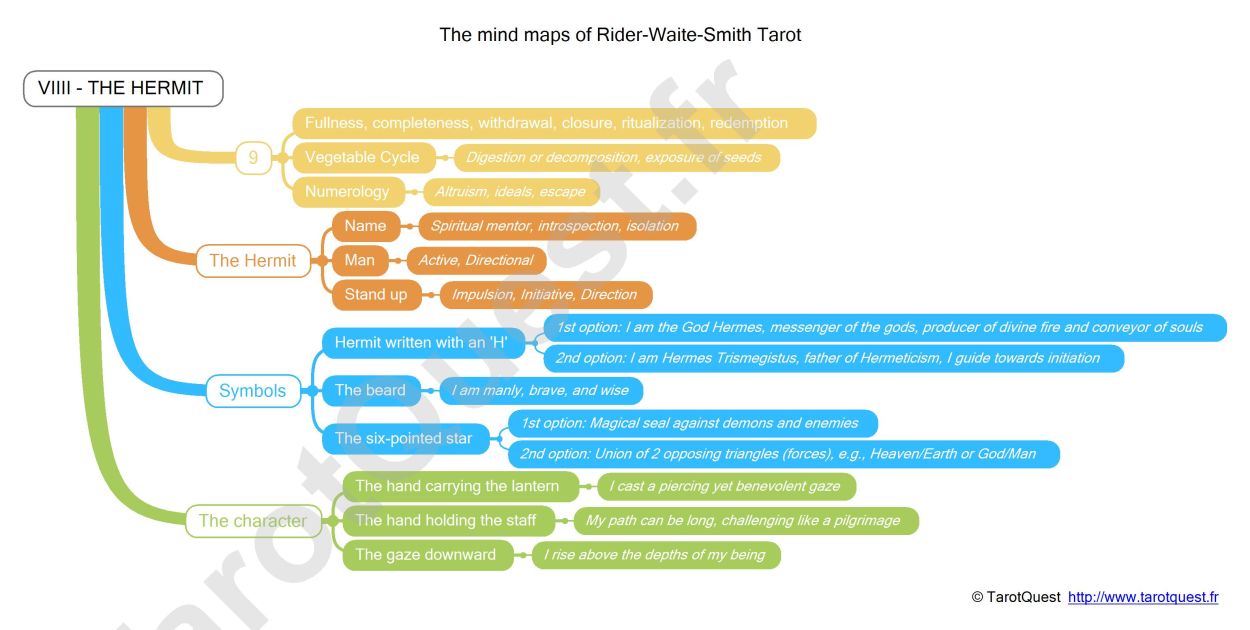



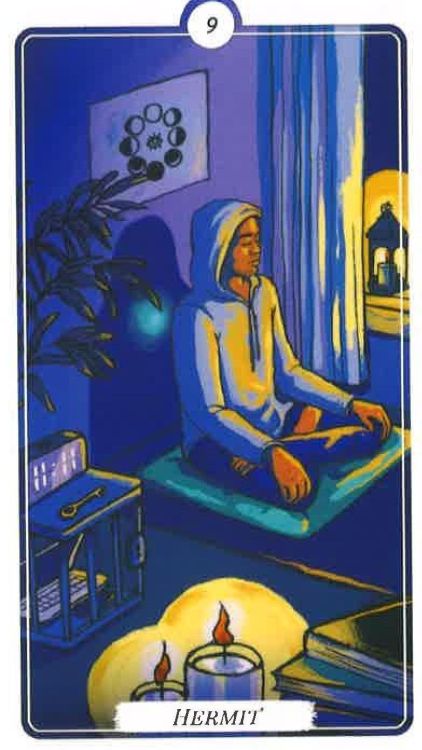

Copyright © TarotQuest.fr